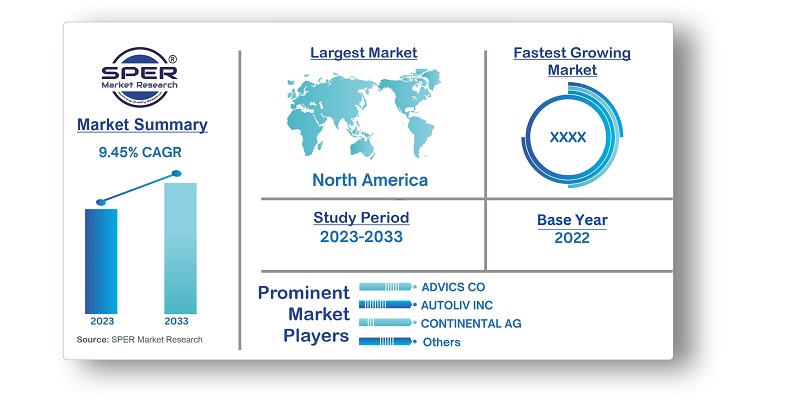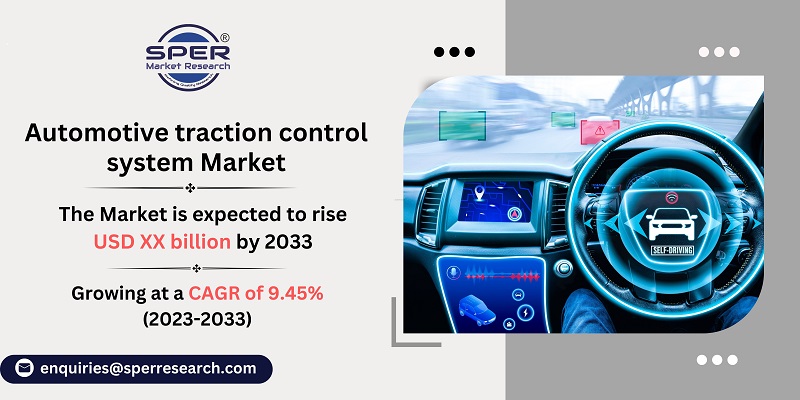
Automotive Traction Control System Market Growth, Size, Trends, Demand and Future Outlook
Automotive Traction Control System Market Size- By Type, By Vehicle Type- Regional Outlook, Competitive Strategies and Segment Forecast to 2033
| Published: Jan-2024 | Report ID: AMIN2412 | Pages: 1 - 234 | Formats*: |
| Category : Automotive & Transportation | |||
- September 2022: A contract worth was given to Ricardo PLC in September 2022 to supply extra Antilock Brake System/Electronic Stability Control (ABS/ESC) upgrade kits for the US Army's High Mobility Multi-Purpose Wheeled Vehicle (HMMWV). The enhanced brake callipers, pads, and rotors of the Ricardo engineered ABS/ESC retrofit system, along with electronic stability control, active rollover prevention, traction control, and antilock braking, are all part of a comprehensive solution integrated into the HMMWV architecture. Along with low-cost, well-proven parts specifically made for military use, the Ricardo system also outfits the automobile with a crashworthy steering column and an advanced electrical network.


| Report Metric | Details |
| Market size available for years | 2019-2033 |
| Base year considered | 2022 |
| Forecast period | 2023-2033 |
| Segments covered | By Type, By Vehicle Type |
| Regions covered | North America, Asia-Pacific, Latin America, Middle East & Africa and Europe |
| Companies Covered | ADVICS CO., LTD, AUTOLIV INC, CONTINENTAL AG, Denso Corporation, Hitachi Ltd., HYUNDAI MOBIS CO., LTD, Nissin Kogyo Co., Ltd., Robert Bosch GmbH, WABCO, ZF TRW |
- Automobile Manufacturers
- Fleet Operators
- Aftermarket Consumers
- Commercial Vehicle Owners
- Automotive Enthusiasts
- Government and Regulatory Bodies
- Insurance Companies
- Fleet Management Companies
- Technology Integrators
| By Type: |
|
| By Vehicle Type: |
|
| By Region: |
|
- Global Automotive Traction Control System Market Size (FY’2023-FY’2033)
- Overview of Global Automotive Traction Control System Market
- Segmentation of Global Automotive Traction Control System Market By Type (Electric Linkage, Mechanical Linkage)
- Segmentation of Global Automotive Traction Control System Market By Vehicle Type (HCV, LCV, Passenger Cars)
- Statistical Snap of Global Automotive Traction Control System Market
- Expansion Analysis of Global Automotive Traction Control System Market
- Problems and Obstacles in Global Automotive Traction Control System Market
- Competitive Landscape in the Global Automotive Traction Control System Market
- Impact of COVID-19 and Demonetization on Global Automotive Traction Control System Market
- Details on Current Investment in Global Automotive Traction Control System Market
- Competitive Analysis of Global Automotive Traction Control System Market
- Prominent Players in the Global Automotive Traction Control System Market
- SWOT Analysis of Global Automotive Traction Control System Market
- Global Automotive Traction Control System Market Future Outlook and Projections (FY’2023-FY’2033)
- Recommendations from Analyst
1.1. Scope of the report1.2. Market segment analysis
2.1. Research data source2.1.1. Secondary Data2.1.2. Primary Data2.1.3. SPER’s internal database2.1.4. Premium insight from KOL’s2.2. Market size estimation2.2.1. Top-down and Bottom-up approach2.3. Data triangulation
4.1. Driver, Restraint, Opportunity and Challenges analysis4.1.1. Drivers4.1.2. Restraints4.1.3. Opportunities4.1.4. Challenges4.2. COVID-19 Impacts of the Global Automotive Traction Control System Market
5.2. PESTEL Analysis5.1.1. Strengths5.1.2. Weaknesses5.1.3. Opportunities5.1.4. Threats
5.3. PORTER’s Five Forces5.2.1. Political Landscape5.2.2. Economic Landscape5.2.3. Social Landscape5.2.4. Technological Landscape5.2.5. Environmental Landscape5.2.6. Legal Landscape
5.4. Heat Map Analysis5.3.1. Bargaining power of suppliers5.3.2. Bargaining power of buyers5.3.3. Threat of Substitute5.3.4. Threat of new entrant5.3.5. Competitive rivalry
6.1. Global Automotive Traction Control System Market Manufacturing Base Distribution, Sales Area, Product Type6.2. Mergers & Acquisitions, Partnerships, Product Launch, and Collaboration in Global Automotive Traction Control System Market
7.1. Global Automotive Traction Control System Market Value Share and Forecast, By Type, 2023-20337.2. Electric Linkage7.3. Mechanical Linkage
8.1. Global Automotive Traction Control System Market Value Share and Forecast, By Vehicle Type, 2023-20338.2. HCV8.3. LCV8.4. Passenger Cars
9.1. Global Automotive Traction Control System Market Size and Market Share
10.1. Global Automotive Traction Control System Market Size and Market Share By Type (2019-2026)10.2. Global Automotive Traction Control System Market Size and Market Share By Type (2027-2033)
11.1. Global Automotive Traction Control System Market Size and Market Share By Vehicle Type (2019-2026)11.2. Global Automotive Traction Control System Market Size and Market Share By Vehicle Type (2027-2033)
12.1. Global Automotive Traction Control System Market Size and Market Share By Region (2019-2026)12.2. Global Automotive Traction Control System Market Size and Market Share By Region (2027-2033)12.3. Asia-Pacific12.3.1. Australia12.3.2. China12.3.3. India12.3.4. Japan12.3.5. South Korea12.3.6. Rest of Asia-Pacific12.4. Europe12.4.1. France12.4.2. Germany12.4.3. Italy12.4.4. Spain12.4.5. United Kingdom12.4.6. Rest of Europe12.5. Middle East and Africa12.5.1. Kingdom of Saudi Arabia12.5.2. United Arab Emirates12.5.3. Rest of Middle East & Africa12.6. North America12.6.1. Canada12.6.2. Mexico12.6.3. United States12.7. Latin America12.7.1. Argentina12.7.2. Brazil12.7.3. Rest of Latin America
13.1. ADVICS CO., LTD13.1.1. Company details13.1.2. Financial outlook13.1.3. Product summary13.1.4. Recent developments13.2. AUTOLIV INC13.2.1. Company details13.2.2. Financial outlook13.2.3. Product summary13.2.4. Recent developments13.3. CONTINENTAL AG13.3.1. Company details13.3.2. Financial outlook13.3.3. Product summary13.3.4. Recent developments13.4. Denso Corporation13.4.1. Company details13.4.2. Financial outlook13.4.3. Product summary13.4.4. Recent developments13.5. Hitachi Ltd13.5.1. Company details13.5.2. Financial outlook13.5.3. Product summary13.5.4. Recent developments13.6. HYUNDAI MOBIS CO., LTD13.6.1. Company details13.6.2. Financial outlook13.6.3. Product summary13.6.4. Recent developments13.7. Nissin Kogyo Co., Ltd.13.7.1. Company details13.7.2. Financial outlook13.7.3. Product summary13.7.4. Recent developments13.8. Robert Bosch GmbH13.8.1. Company details13.8.2. Financial outlook13.8.3. Product summary13.8.4. Recent developments13.9. WABCO13.9.1. Company details13.9.2. Financial outlook13.9.3. Product summary13.9.4. Recent developments13.10. ZF TRW13.10.1. Company details13.10.2. Financial outlook13.10.3. Product summary13.10.4. Recent developments13.11. Others
SPER Market Research’s methodology uses great emphasis on primary research to ensure that the market intelligence insights are up to date, reliable and accurate. Primary interviews are done with players involved in each phase of a supply chain to analyze the market forecasting. The secondary research method is used to help you fully understand how the future markets and the spending patterns look likes.
The report is based on in-depth qualitative and quantitative analysis of the Product Market. The quantitative analysis involves the application of various projection and sampling techniques. The qualitative analysis involves primary interviews, surveys, and vendor briefings. The data gathered as a result of these processes are validated through experts opinion. Our research methodology entails an ideal mixture of primary and secondary initiatives.



Frequently Asked Questions About This Report
PLACE AN ORDER
Year End Discount
Sample Report
Pre-Purchase Inquiry
NEED CUSTOMIZATION?
Request CustomizationCALL OR EMAIL US
100% Secure Payment






Related Reports
Our Global Clients
Our data-driven insights have influenced the strategy of 200+ reputed companies across the globe.




















